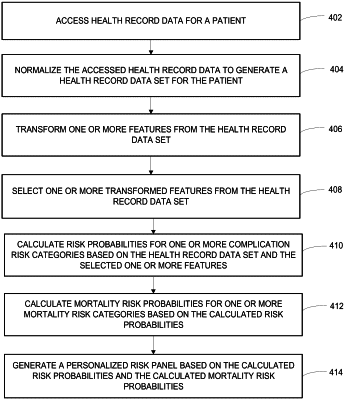| CPC G16H 50/30 (2018.01) [G06N 7/01 (2023.01); G16H 10/60 (2018.01); G16H 20/40 (2018.01)] | 20 Claims |

|
1. A surgery risk analytics system for surgical risk evaluation based at least in part on a surgery risk analytics platform service, the surgery risk analytics system comprising a processor and a memory having computer coded instructions therein when executed by the processor, cause the surgery risk analytics system to:
receive, using a data transformer module, health record data associated with monitoring of a patient for surgery risks via a client device, the health record data comprising a plurality of variables associated with a plurality of features, the plurality of features comprising a plurality of perioperative predictor features;
normalize, using the data transformer module, the received health record data by replacing missing values of one or more of the plurality of variables with replacement values based at least in part on variable type and by preprocessing the one or more of the plurality of variables based at least in part on respective one or more of a plurality of preprocessing types associated with the one or more of the plurality of variables;
transform, using the data transformer module, one or more of the plurality of features by optimizing the plurality of variables based at least in part on one or more conditional properties associated with a plurality of outcomes, thereby conforming the plurality of variables with inputs of a plurality of predictive models of a data analytics module based at least in part on the optimizing, wherein the plurality of variables are optimized by substituting the plurality of variables with probability ratios associated with ordered variables, wherein each of the plurality of predictive models is associated with a given complication risk and is configured to (i) generate one or more complication risk probabilities based at least in part on the one or more transformed features and (ii) execute independently from other ones of the plurality of predictive models;
select, using the data transformer module, the one or more transformed features based at least in part on variance factors of the one or more transformed features, the variance factors comprising a likelihood of excessive collinearity;
generate, using the plurality of predictive models, a plurality of complication risk probabilities for a plurality of respective complication risks associated with the plurality of predictive models based at least in part on the health record data and the selected one or more features;
generate, using one or more trained machine learning classifier models of the data analytics module, one or more mortality risk probabilities at given future times after a surgery event, wherein (i) the one or more trained machine learning classifier models comprises a plurality of random forest classifiers that are trained to generate a plurality of predictions associated with respective ones of the plurality of outcomes based at least in part on training data comprising the plurality of complication risk probabilities and (ii) the one or more mortality risk probabilities comprise an aggregation of the plurality of predictions;
generate, using an output generator, a user interface configured to render a personalized risk panel for the patient based at least in part on the plurality of complication risk probabilities and the one or more mortality risk probabilities; and
transmit the personalized risk panel from the output generator to the client device for graphical output on a client application executing on the client device, wherein (i) the personalized risk panel comprises results of the monitoring and a determination of level of care based at least in part on the plurality of complication risk probabilities and the one or more mortality risk probabilities and (ii) the personalized risk panel is associated with a surgery risk analytics platform that is configured for medical decision making associated with modifying surgical planning or staffing before or during surgery on the patient based at least in part on the personalized risk panel.
|